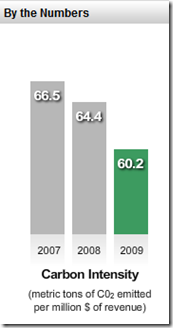Verizon has a press release on its new carbon metric.
Verizon Develops New Metric to Accurately Measure Company's Carbon Efficiency as Broadband, IP, Wireless and Video Services Grow
Metric Will Help Company to Continue Its Energy-Conservation Improvements Amid Increasing Demands on Its Network
NEW YORK – April 28, 2011 –
Verizon has developed a new metric for measuring carbon efficiency, enabling the company, for the first time, to accurately quantify the impact of all of its green initiatives.
The metric will help Verizon continue to make improvements in energy conservation and efficiency, as the rapid increase in demand for broadband, IP network services, wireless data and video increases the demands on the company's network - and the amount of energy needed to operate the network.
Called the "carbon intensity metric," the new measurement was developed by Verizon's Sustainability Office and tested over the past 12 months. The tests showed an improvement of approximately 15 percent in the company's carbon efficiency, from 2009 to 2010.
The metric is derived by first combining Verizon's total carbon emissions (in metric tons) from the electricity, building fuels and vehicle fuels used to run the company's business. Then, that total is divided by the number of terabytes of data that the company transports across its network. (One terabyte equals about 300 feature-length movies.) Verizon transported 78.6 million terabytes across its global network in 2010 - an increase of about 16 percent, compared with 2009.
We’ll see if others adopt this method.
One area where I found deceptive is this graph on the Verizon environmental site.
Note how the scale is not provided from 2007 – 2009 there is 10% reduction, but the graph deception makes the reduction look like over 33%. It’s too bad you can’t make money by finding deceptive graphing techniques, it would keep the marketing folks a lot more honest.
